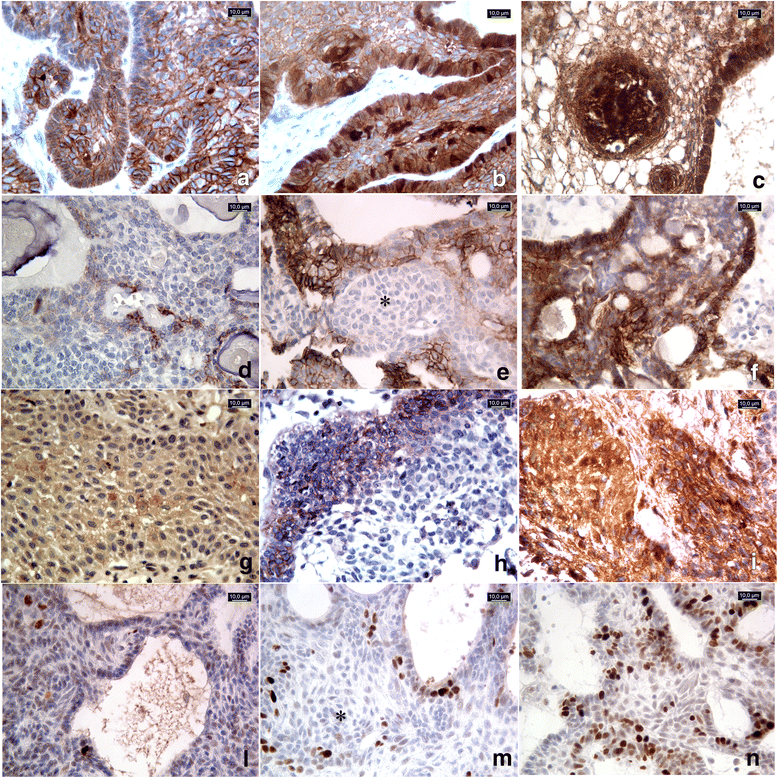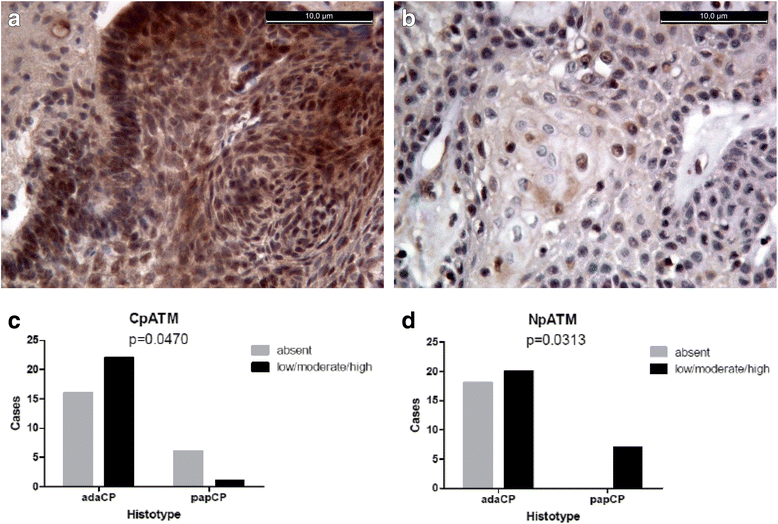Can recurrences be predicted in craniopharyngiomas? β-catenin coexisting with stem cells markers and p-ATM in a clinicopathologic study of 45cases
- PMID: 28709442
- PMCID: PMC5512957
- DOI: 10.1186/s13046-017-0562-9
Can recurrences be predicted in craniopharyngiomas? β-catenin coexisting with stem cells markers and p-ATM in a clinicopathologic study of 45cases
Abstract
Background: Recurrence is a common feature of craniopharyngiomas, benign tumors that origin from squamous epithelial remnants of Rathke's pouch- arising at any segment of its whole course. There are two histotypes, showing different morphology and clinical behavior: adamantinomatous(adaCP) and papillary (papCP). An univocal strategy of management has not yet been defined, being considered the combination of surgery and radiotherapy the most effective, especially in case of incomplete resection. Therefore, the identification of factors influencing the biological and clinical behaviour is of paramount importance. β-catenin is a cell-cell adhesion protein, whose nuclear localization has been linked to the pathogenesis of adaCP: its nuclear accumulation is associated to the presence of a tumor stem cell subpopulation. The latter is made of cells capable of self-renewal, hence believed to be responsible of recurrence, metastases and resistance to therapy in all tumors. ATM is a kinase activated by autophosphorylation (p-ATM) upon DNA double-strand breaks. It is involved not only in DNA repair, but also in tumor migration and invasiveness. Its expression may have prognostic implications in many neoplastic diseases.
Methods: In this study, we measured the immunohistochemical expression of β-catenin, stem cell markers (CD133, CD166), Ki67 and pATMin 45 craniopharyngiomas and correlated it with clinicopathologic features.
Results: Statistical analysis revealed strong correlation of β-catenin with recurrence (p = 0.0039), Ki67 (p = 0.0011, r = 0.4903) and CD166 (p = 0.0002, r = 0.6218). A slight tendency to a higher expression of β-catenin was recorded for adaCP rather than papCP (p = 0.0895).Fisher's exact test showed that CD166 was significantlyrelated with recurrence (p = 0.0040). Furthermore, cytoplasmic pATM was more expressed in adaCPs (p = 0.0470), compared to papCPs that displayed a more evident nuclear signal (p = 0.0313) instead.
Conclusions: Backing upon these data, we could weigh in on the need of identifying β-catenin and CD166 as prognostic markersthat could be useful in predicting thebiologicalbehavior, as recurrence risk incraniopharyngiomas. The final goal is to drew up a prognostic algorithm to be of aid in the planning of an appropriate treatment strategy. Furthermore, our findings demonstrate that pATM could be used as additional distinction-marker between the two histotypes.
Keywords: CD166; Craniopharyngiomas; Recurrence; β-catenin.
Conflict of interest statement
Ethics approval and consent to participate
This was a retrospective study with tissue samples retrieved from the archives of our Institute. For each patient a written informed consent to use part of the specimen for scientific and/or research scopes was available. Therefore, the project was not submitted to a named institutional and/or licensing committee.
Consent for publication
Not applicable.
Competing interests
None to declare.
Publisher’s Note
Springer Nature remains neutral with regard to jurisdictional claims in published maps and institutional affiliations.
Figures


Similar articles
-
Adamantinomatous craniopharyngiomas express tumor stem cell markers in cells with activated Wnt signaling: further evidence for the existence of a tumor stem cell niche?Pituitary. 2014 Dec;17(6):546-56. doi: 10.1007/s11102-013-0543-8. Pituitary. 2014. PMID: 24356780
-
Expression of aberrant beta-catenin and impaired p63 in craniopharyngiomas.Br J Neurosurg. 2010 Jun;24(3):249-56. doi: 10.3109/02688690903576237. Br J Neurosurg. 2010. PMID: 20128632
-
Possible linkage between specific histological structures and aberrant reactivation of the Wnt pathway in adamantinomatous craniopharyngioma.J Pathol. 2004 Jul;203(3):814-21. doi: 10.1002/path.1562. J Pathol. 2004. PMID: 15221941
-
Molecular and cellular pathogenesis of adamantinomatous craniopharyngioma.Neuropathol Appl Neurobiol. 2015 Oct;41(6):721-32. doi: 10.1111/nan.12226. Epub 2015 Apr 23. Neuropathol Appl Neurobiol. 2015. PMID: 25611703 Free PMC article. Review.
-
Pathology and pathogenesis of craniopharyngiomas.Pituitary. 2013 Mar;16(1):9-17. doi: 10.1007/s11102-012-0418-4. Pituitary. 2013. PMID: 22886701 Review.
Cited by
-
Pathological and Prognostic Characterization of Craniopharyngioma Based on the Expression of TrkA, β-Catenin, Cell Cycle Markers, and BRAF V600E Mutation.Front Endocrinol (Lausanne). 2022 May 30;13:859381. doi: 10.3389/fendo.2022.859381. eCollection 2022. Front Endocrinol (Lausanne). 2022. PMID: 35707464 Free PMC article.
-
Activated leukocyte cell adhesion molecule expression correlates with the WNT subgroup in medulloblastoma and is involved in regulating tumor cell proliferation and invasion.PLoS One. 2020 Dec 3;15(12):e0243272. doi: 10.1371/journal.pone.0243272. eCollection 2020. PLoS One. 2020. PMID: 33270750 Free PMC article.
-
Ki67 as a prognostic factor of craniopharyngioma's recurrence in paediatric population.Childs Nerv Syst. 2020 Jul;36(7):1461-1469. doi: 10.1007/s00381-020-04519-4. Epub 2020 Feb 7. Childs Nerv Syst. 2020. PMID: 32034518 Free PMC article.
-
Genomic drivers in craniopharyngiomas: Analysis of the AACR project GENIE database.Childs Nerv Syst. 2024 Jun;40(6):1661-1669. doi: 10.1007/s00381-024-06320-z. Epub 2024 Feb 29. Childs Nerv Syst. 2024. PMID: 38421446
-
Aggressive Childhood-onset Papillary Craniopharyngioma Managed With Vemurafenib, a BRAF Inhibitor.J Endocr Soc. 2021 Mar 16;5(5):bvab043. doi: 10.1210/jendso/bvab043. eCollection 2021 May 1. J Endocr Soc. 2021. PMID: 33928205 Free PMC article.
References
-
- Louis DN, Ohgaki H, Wiestler OD, Cavenee WK. WHO classification of tumours of the central nervous system. Lyon: Int Agency Res. 4th Edition revised, 2016.
MeSH terms
Substances
LinkOut - more resources
Full Text Sources
Other Literature Sources
Research Materials
Miscellaneous

